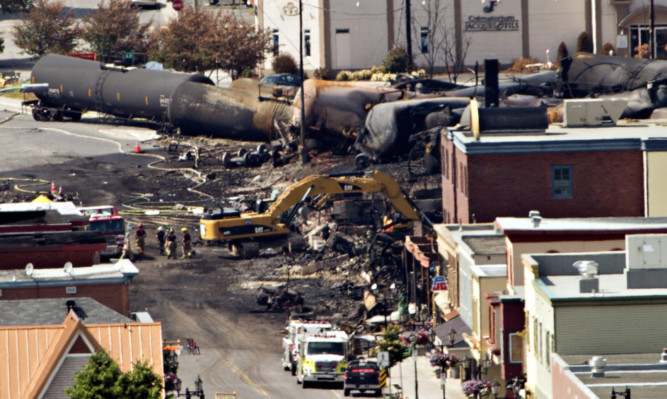Traumatised survivors of a Canadian oil train crash that wiped out the heart of a small town braced for more bad news as inspectors were cleared to enter the charred site’s epicentre and look for remains.
The disaster killed at least 13 people, but a total of 50 were missing and the death toll was sure to rise.
Quebec provincial police Sergeant Benoit Richard said eight more bodies had been found in the wreckage after firefighters doused the flames and cooled down some of the oil tankers that were in danger of exploding.
Five bodies were found over the weekend, and police would not say where the newly discovered ones were, for fear of upsetting families.
All but one of the train’s 73 tanker cars were carrying oil when they came loose early on Saturday, sped downhill nearly seven miles into the town of Lac-Megantic, near the Maine border, and derailed. At least five of the cars exploded.
The blasts destroyed about 30 buildings, including a public library and Musi-Cafe, a popular bar that was filled with revellers, and forced about a third of the town’s 6000 residents from their homes.
Much of the area where the bar once stood was burned to the ground. Burned-out car frames dotted the landscape.
The derailment raised questions about the safety of Canada’s growing policy of transporting oil by train, and was sure to bolster arguments that a proposed oil pipeline running from Canada across the US would be safer.
Raymond Lafontaine, who believed he lost three members of his family, including his son, said he was angry with what appeared to be lack of safety regulations.
“We always wait until there’s a big accident to change things,” he said. “Well, today we’ve had a big accident, it’s one of the biggest ever in Canada.”
The fires sparked by the exploding tanks burned for two days, impeding investigators from reaching some of the “hot spots,” including the area near the destroyed Musi-Cafe.
“It’s a zone that we’ve started to work on and we’ll work on it more in the hours to come,” Mr Richard said.
The area remained part of a criminal investigation and they were exploring all options, including the possibility that someone intentionally tampered with the train, he said.
Canadian Transport Minister Denis Lebel said the train was inspected the day before the accident in Montreal and no deficiencies were found.
He defended his government against criticisms it had cut back on rail safety measures, and said rail remains a safe way to transport goods the vast majority of the time.
The train’s owners said they believed brake failure was to blame.
Officials were also looking at a locomotive blaze on the same train a few hours before the derailment.
The growing number of trains transporting crude oil in Canada and the US had raised concerns of a major disaster.
Canada has been pushing the Obama administration to approve the controversial Keystone XL oil pipeline from Canada to the US Gulf Coast.
The train’s oil was being transported from North Dakota’s Bakken oil region to a refinery in New Brunswick on Canada’s East Coast.
Because of limited pipeline capacity in the Bakken region and in Canada, oil producers are increasingly using railroads to transport oil to refineries.
The Canadian Railway Association has estimated as many as 140,000 carloads of crude oil will be shipped on Canada’s tracks this year – up from 500 carloads in 2009.
The Quebec disaster is the fourth freight train accident in Canada under investigation involving crude oil shipments since the beginning of the year.
